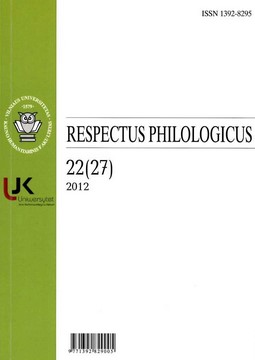НАНОЛИНГВИСТИКА: РЕАЛЬНОСТЬ СУЩЕСТВОВАНИЯ
NANOLINGUISTICS: REALITY OF EXISTENCE
Author(s): Lara SinelnikovaSubject(s): Philosophy of Language, Philology, Theory of Literature
Published by: Vilniaus Universiteto Leidykla
Keywords: nanolinguistics; nanotechnology; size effect; quasi-morphemes; “double bind”- type communication; avant-garde poetry; sensory linguistics; Nano sapiens;
Summary/Abstract: The article is devoted to understanding nanolinguistics as a post-non-classical branch of science which is based on interdisciplinary methodology. Arguments for the existence of nanolinguistics rely on the “scale factor” as a key point: changes in size reveal new characteristics of an object. The nanolevel is founded on special optics, which allow features that are not always seen but nevertheless exist (in an essential way) to be studied, leading to an understanding of the characteristics of the substance’s self-organization and its interaction with other objects, including the possibilities and results of integration. Nanolinguistics searches for ways to thoroughly examine an object. At the same time, previous experience of the interpretation of linguistic phenomena stimulates the subsequent steps of reasoning for accumulating knowledge about the object’s characteristics. Nanolinguistics is an interdisciplinary field of knowledge, the subject of which can be those units and cognitive-discursive manifestations that are nanostructured, i.e., those that consist of quantities which can be indexed as subtle properties of the linguistic substance. Nanoparticles are revealed by interpreting an object’s layerwise assembly, taking into account its coreferential relations, as a result of which integration into larger-scale systems takes place; microcosm and macrocosm become organically connected. This article introduces the possibilities of nanolinguistic interpretative actions in the sphere of modern word formation (the new assembly of morphemes to create a new referential basis); in studying the processes of adaptation of loanwords (quasi-synonymy, the variation of interpretations in a new environment); in the evaluation of political communication (the principle of extremely low influence in the situation of a double bind or double trap); in sensory linguistics (the language of perception that reflects subtle shades of the sensory understanding of the world); and in avant-garde poetry (poetic dispersion, or the fragmentation of the “matter” of a word into particles and their combination into new mental images). Prospects for the development of nanolinguistics are indicated.
Journal: Respectus Philologicus
- Issue Year: 2012
- Issue No: 22(27)
- Page Range: 130-143
- Page Count: 14
- Language: Russian

